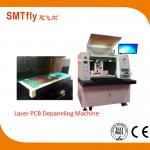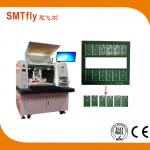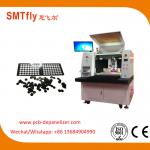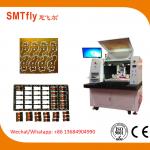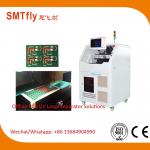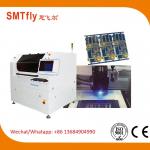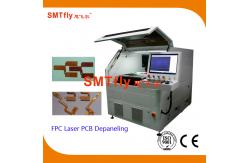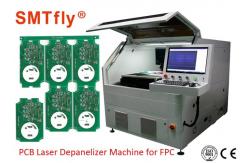Industrial PCB Laser Depaneling with Different Laser Source
10/12/15/17W
PCB depaneling (singulation) laser machines and systems have been
gaining popularity over recent years. Mechanical
depanaling/singulation is done with routing, die cutting, and
dicing saw methods. However, as the boards get smaller, thinner,
flexible, and more sophisticated, those methods produce even more
exaggerated mechanical stress to the parts. Large boards with heavy
substrates absorb these stresses better, while these methods used
on ever-shrinking and complex boards can result in breakage. This
brings lower throughput, along with the added costs of tooling and
waste removal associated with mechanical methods.
Increasingly, flexible circuits are found in the PCB industry, and
they also present challenges to the old methods. Delicate systems
reside on these boards and non-laser methods struggle to cut them
without damaging the sensitive circuitry. A non-contact depaneling
method is required and lasers provide a highly precise way of
singulation without any risk of harming them, regardless of
substrate.
Challenges of Depaneling using Routing/Die Cutting/Dicing Saws
- Damages and fractures to substrates and circuits due to mechanical
stress
- Damages to PCB due to accumulated debris
- Constant need for new bits, custom dies, and blades
- Lack of versatility – each new application requires ordering of
custom tools, blades, and dies
- Not good for high precision, multi-dimensional or complicated cuts
- Not useful PCB depaneling/singulation smaller boards
Lasers, on the other hand, are gaining control of the PCB
depaneling/singulation market due to higher precision, lower stress
on the parts, and higher throughput. Laser depaneling can be
applied to a variety of applications with a simple change in
settings. There is no bit or blade sharpening, lead time reordering
dies and parts, or cracked/broken edges due to torque on the
substrate. Application of lasers in PCB depaneling is dynamic and a
non-contact process.
Advantages of Laser PCB depaneling/singulation
- No mechanical stress on substrates or circuits
- No tooling cost or consumables.
- Versatility – ability to change applications by simply changing
settings
- Fiducial Recognition – more precise and clean cut
- Optical Recognition before PCB depaneling/singulation process
begins. CMS Laser is one of the few companies to provide this
feature.
- Ability to depanel virtually any substrate. (Rogers, FR4, ChemA,
Teflon, ceramics, aluminum, brass, copper, etc)
- Extraordinary cut quality holding tolerances as small as < 50
microns.
- No design limitation – ability to cut virtually and size PCB board
including complex contours and multidimensional boards
Specification
| Parameter | |
Technical parameters | Main body of laser | 1480mm*1360mm*1412 mm |
| Weight of the | 1500Kg |
| Power | AC220 V |
| Laser | 355 nm |
| Laser | Optowave 10W(US) |
| Material | ≤1.2 mm |
| Precisio | ±20 μm |
| Platfor | ±2 μm |
| Platform | ±2 μm |
| Working area | 600*450 mm |
| Maximum | 3 KW |
| Vibrating | CTI(US) |
| Power | AC220 V |
| Diameter | 20±5 μm |
| Ambient | 20±2 ℃ |
| Ambient | <60 % |
| The Machine | Marble |
